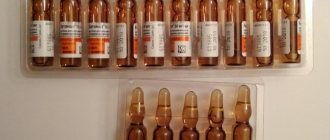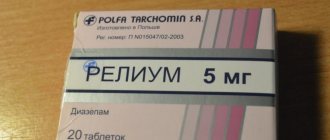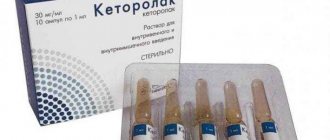Compound
Pills
Each contains 10 mg metoclopramide hydrochloride .
Additional components: sodium starch glycolate, magnesium stearate, anhydrous colloidal silicon, lactose, purified talc starch (corn).
Solution
1 ml contains 5 mg of the active substance metoclopramide hydrochloride .
Auxiliary components: glacial acetic acid, sodium acetate, sodium metabisulfite, disodium ethylenediaminetetraacetic acid, water.
Composition and release form
The drug is dispensed in the form of tablets and solution for injection.
The active ingredient is metoclopramide hydrochloride. Excipients:
- Saline.
- Acetic acid.
- Water for injections.
- Sodium sulfite.
- Edetate disodium.
Sold without a doctor's prescription. The cardboard package contains 1 bottle of clear liquid or 1-5 blisters of 10 tablets with attached instructions.
Shelf life 2 years. Optimal conditions are temperatures up to +25 C, in a dark place, away from children.
pharmachologic effect
What is Metoclopramide for?
The medication has an antiemetic effect , has a stimulating effect on the peristalsis of the digestive tract, and reduces the severity of hiccups and nausea. The mechanism of action is based on blocking dopamine D2 receptors, increasing the threshold of chemoreceptors located in the trigger area, and blocking serotonin receptors.
There is an assumption that the active substance is capable of inhibiting the relaxation of smooth muscle tissue of the stomach, which is caused by Dopamine .
The drug accelerates gastric emptying by relaxing the body, increasing the activity of the upper parts of the small intestine and the antrum of the stomach. By increasing the pressure of the esophageal sphincter at rest, it reduces the reflux of contents into the lumen of the esophagus.
Increasing the amplitude of peristaltic contractions increases acid clearance. It has been noted that the active component stimulates the production of prolactin aldosterone levels , which can lead to fluid retention in the body (the effect is reversible).
Mechanism of action
Metoclopramide blocks dopamine receptors, which are located in the nervous system, which helps eliminate the gag reflex and nausea associated with various causes, including nausea during early or late gestosis of pregnancy, nausea during labor.
The drug stimulates the contraction of smooth muscle cells of the digestive tract, especially in the upper sections (esophagus, stomach, duodenum), normalizes intestinal motor function, increases pressure in the gallbladder and ducts, which promotes better outflow of bile and the breakdown of food products found in the duodenum.
Additionally , Metoclopramide also increases the production of prolactin, a hormone that is responsible for the production and quantity of breast milk in the postpartum period.
Indications for use of Metoclopramide
Metoclopramide - what are these tablets for?
Most often, the medication is used to relieve nausea, vomiting and hiccups of various origins (including after treatment with cytostatics and radiation therapy).
Main indications for the use of Metoclopramide:
- increased gas formation;
- reflux esophagitis (reflux of contents with subsequent irritation of the walls of the esophagus);
- hypotension, atony of the intestines, stomach (including in the postoperative period);
- pyloric stenosis of functional origin;
- biliary dyskinesia (hypomotor mechanism of development);
- for peptic ulcer of the digestive tract (as part of complex therapy);
- accelerating the movement of food through the digestive tract (stomach + small intestine) before duodenal intubation;
- increased peristalsis before X-ray contrast examinations of the digestive system.
Metoclopramide
The frequency of adverse reactions is given according to the classification: very often (≥ 1/10); often (≥1/100, <1/10); uncommon (≥1/1000, <1/100); rare (≥1/10000, <1/1000); very rare (<1/10000); frequency unknown (frequency cannot be estimated from available data).
Blood and lymphatic system disorders:
frequency unknown - methemoglobinemia, probably associated with deficiency of the enzyme NADH-dependent cytochrome b5 reductase (especially in newborns), sulfhemoglobinemia (most often with the simultaneous use of high doses of sulfur-containing drugs).
Cardiac disorders:
infrequently - bradycardia; frequency unknown - cardiac arrest, which may be caused by bradycardia, atrioventricular block, sinus node block, prolongation of the QT interval on the electrocardiogram, ari.
Vascular disorders:
often - decreased blood pressure, frequency unknown - cardiogenic shock, acute increase in blood pressure in patients with pheochromocytoma.
Endocrine system disorders*
: infrequently - amenorrhea, hyperprolactinemia; rarely - galactorrhea; frequency unknown - gynecomastia.
* Endocrine disorders during long-term treatment are associated with hyperprolactinemia (amenorrhea, galactorrhea, gynecomastia).
Gastrointestinal disorders:
often - diarrhea; rarely - dry mouth.
Immune system disorders:
uncommon - hypersensitivity reactions; frequency unknown - anaphylactic reactions (including anaphylactic shock).
Nervous system disorders:
very often - drowsiness; often - extrapyramidal disorders (especially in children and young patients and/or when recommended doses of the drug are exceeded, even after a single administration), parkinsonism, akathisia; infrequently - dystonia, dyskinesia, impaired consciousness; rarely - seizures, especially in patients with epilepsy; frequency unknown - tardive dyskinesia, sometimes persistent, during or after long-term treatment, especially in elderly patients, neuroleptic malignant syndrome.
Mental disorders:
often - depression; infrequently - hallucinations; rarely - confusion.
General disorders and disorders at the injection site:
often - asthenia.
Adverse reactions that are most common when using high doses of the drug:
— Extrapyramidal symptoms: acute dystonia and dyskinesia, parkinsonism syndrome, akathisia developed even after using a single dose of the drug, especially in children and young patients (see section “Special instructions”),
- Drowsiness, decreased level of consciousness, confusion, hallucinations.
Contraindications
- intestinal obstruction of a mechanical nature;
- stenosis of the pylorus of the stomach;
- bleeding in the digestive system;
- perforation of the walls of the intestine, stomach;
- diagnosed glaucoma , suspicion of it;
- epilepsy;
- pheochromocytoma;
- bronchial asthma in patients with hypersensitivity to sulfites;
- prolactin-dependent neoplasms;
- Parkinson's disease;
- extrapyramidal disorders;
- vomiting during treatment with antipsychotics in patients suffering from breast cancer;
- individual hypersensitivity.
The drug is not used in the postoperative period in patients with pyloroplasty and intestinal anastomosis, because Vigorous muscle contractions impair healing.
Relative contraindications:
- childhood (possible development of dyskinetic syndrome);
- old age (65 years and older);
- Parkinson's disease;
- bronchial asthma;
- diseases of the kidney and liver system;
- hypertonic disease.
Metoclopramide, 5 mg/ml, solution for intravenous and intramuscular administration, 2 ml, 10 pcs.
The frequency of adverse reactions is classified as follows: very common (≥1/10), common (≥1/100–<1/10), uncommon (≥1/1000–<1/100), rare (≥1/10000–< 1/1000), very rare (<1/10000), frequency unknown (cannot be estimated based on available data).
From the digestive system:
at the beginning of treatment, constipation, diarrhea, nausea are possible; rarely - dry mouth.
From the central nervous system:
at the beginning of treatment, feelings of fatigue, drowsiness, dizziness, headache, depression, asthenia, extrapyramidal disorders are possible (especially in children and young patients and/or when the recommended doses of the drug are exceeded, even after a single administration); infrequently - dystonia, disturbances of consciousness; rarely - seizures (especially in patients with epilepsy); frequency unknown - tardive dyskinesia, which may be permanent, during or after long-term treatment (especially in elderly patients), neuroleptic malignant syndrome. With long-term use, more often in elderly patients, parkinsonism and dyskinesia are possible.
Mental disorders:
often - depression; infrequently - hallucinations; rarely - confusion.
From the hematopoietic and lymphatic systems:
agranulocytosis is possible at the beginning of treatment; frequency unknown - methemoglobinemia, which may be associated with deficiency of the enzyme NADH-cytochrome b5 reductase, especially in newborns; sulfhemoglobinemia caused by sulfur-containing substances in the composition of the drug (mainly with the concomitant use of high doses of drugs containing sulfur); leukopenia, neutropenia.
From the heart:
rarely - bradycardia; frequency unknown - cardiac arrest, which may be caused by bradycardia; atrioventricular block, sinus node block (especially with intravenous administration), prolongation of the QT interval on the electrocardiogram, torsade de pointes.
From the side of blood vessels:
often - hypotension, especially with intravenous administration; frequency unknown - cardiogenic shock, syncope after injection, acute arterial hypertension in patients with pheochromocytoma.
From the endocrine system*:
uncommon - amenorrhea, hyperprolactinemia; rarely - galactorrhea; frequency unknown - gynecomastia).
*Endocrine disorders during long-term treatment are associated with hyperprolactinemia (amenorrhea, galactorrhea, gynecomastia).
From the immune system:
uncommon - hypersensitivity; frequency unknown - anaphylactic reactions (including anaphylactic shock).
Allergic reactions:
rarely - urticaria, maculopapular rash.
From the kidneys and urinary tract:
frequency unknown - polyuria, urinary incontinence.
From the genital organs and breast:
unknown frequency - sexual dysfunction, priapism.
Adverse reactions that are most common when using high doses of the drug metoclopramide: extrapyramidal symptoms: acute dystonia and dyskinesia, parkinsonism syndrome, akathisia developed even after using a single dose of the drug, especially in children and young patients (see section “Special instructions”); drowsiness, decreased level of consciousness, confusion, hallucinations.
Side effects
Digestive tract:
- dry mouth;
- stool disorders ( constipation , diarrhea syndrome ).
Hematopoietic system:
- sulfagemoglobinemia in adults;
- leukopenia;
- neutropenia.
Cardiovascular system, metabolism:
- porphyria;
- AV block.
Nervous system:
- anxiety;
- fast fatiguability;
- parkinsonism (hyperkinesis, muscle rigidity as a result of the dopamine-blocking effect);
- rhythmic protrusion of the tongue;
- extrapyramidal disorders (oculogyric crisis, bulbar type of speech, opisthotonus, spasmodic torticollis , trismus);
- dyskinesis (with kidney pathology);
- depressed mood;
- migraine headaches;
- noise in ears;
- confusion;
- drowsiness.
Allergic responses:
- angioedema;
- bronchospasm;
- hives.
Endocrine system:
- menstrual irregularities (dysmenorrhea, amenorrhea );
- galactorrhea;
- gynecomastia.
In the first days of therapy, agranulocytosis may develop. In some cases, hyperemia of the nasal mucosa is noted.
Overdose
In case of non-compliance with the therapeutic dose, an overdose is possible. It manifests itself with a pronounced clinical picture in the form of nervous disorders. Hallucinations and unclear consciousness are noted.
Rarely - deterioration of the cardiovascular system with a decrease in blood pressure, the appearance of bradycardia, even cardiac arrest.
Signs of an overdose last a day after starting to take the drug.
Treatment based on symptoms, medication with monitoring of cardiac and respiratory function.
Instructions for use of Metoclopramide (Method and dosage)
Metoclopramide tablets, instructions for use
Regimen for adults: 3-4 times a day, 5-10 mg. When taken orally, the maximum single dosage is 20 mg. You can take no more than 60 mg per day.
Instructions for use of Metoclopramide-Darnitsa
The tablets are intended to be taken orally, the preferred time is 30 minutes before meals. The daily dose of 30-40 mg is designed for 3-4 doses. The course lasts 4-6 weeks. If necessary, treatment can be prescribed for 6 months.
The solution is intended for intramuscular and intravenous administration. The medicine is administered 1-3 times a day, 10-20 mg. For patients taking cytostatics and after radiation therapy, to prevent vomiting and nausea, the solution is administered intravenously, calculating the dose according to the scheme - 2 mg/kg. Before X-ray examinations, the drug is administered over 5-15 minutes at a dose of 10-20 mg.
Interaction
Cholinesterase inhibitors weaken the effect of the drug. The risk of developing extrapyramidal disorders increases significantly with simultaneous therapy with antipsychotics.
Metoclopramide can increase the activity of histamine H2 receptor blockers, enhance the sedative effect of hypnotics, and aggravate the effect of ethanol on the nervous system. The drug enhances absorption:
- Tetracycline (including tetracycline antibiotics);
- ethanol;
- Levodopa;
- Acetylsalicylic acid;
- Paracetamol;
- Diazepam.
Metoclopramide Vial slows down the absorption of the following drugs:
- Cimetidine;
- Digoxin.
Analogs
Level 4 ATX code matches:
Passazhix
Motinorm
Domrid
Motilium
Itomed
Domperidone
Motilak
Ganaton
Cerucal
Structural analogues:
- Cerucal;
- Raglan;
- Metamol.
Metoclopramide price, where to buy
Price for Metoclopramide tablets
In Ukraine, the drug can be purchased for 28 UAH (Metoclopramide-Darnitsa).
The price of Metoclopramide in injections in Russia is 70 rubles.
- Online pharmacies in RussiaRussia
- Online pharmacies in UkraineUkraine
- Online pharmacies in KazakhstanKazakhstan
ZdravCity
- Metoclopramide solution for intravenous and intramuscular injection.
5 mg/ml 2 ml 10 pcs. Federal State Unitary Enterprise Moscow Endocrine Plant 104 rub. order - Metoclopramide Welfarm solution i.v. i.m. 5 mg/ml 2ml No. 10Velfarm LLC
118 RUR order
- Metoclopramide solution for IV and IM administration 5 mg/ml ampoule 2 ml 10 pcs PAO Biosintez
55 rub. order
- Metoclopramide-Vial solution for intravenous and intramuscular injection. 5mg/ml amp. 2ml No. 10 CSP Oui Pharmaceutical Co. Ltd
66 RUR order
- Metoclopramide solution for intravenous and intramuscular injection. 5mg/ml 2ml No. 10Biokhimik JSC
59 RUR order
show more
Pharmacy24
- Metoclopramide-Darnitsa 0.5% 2 ml No. 10 solution
41 UAH. order - Metoclopramide-Darnitsa 0.01 g No. 50 tablets PrAT" Pharmaceutical company "Darnitsa", Ukraine
41 UAH order
- Metoclopramide hydrochloride 5 mg/ml 2 ml No. 10 solution for injection
36 UAH order
PaniPharmacy
- Metoclopramide ampoule Metoclopramide solution for injection 0.5% ampoule 2ml No. 10 Ukraine, Darnitsa ChAO
45 UAH order
- Metoclopramide tablets Metoclopramide tablets. 10mg No. 50 Ukraine, Darnitsa ChAO
45 UAH order
- Metoclopramide ampoule Metoclopramide solution for injection 5 mg/ml ampoule 2 ml No. 10 Ukraine, Borshchagovsky Chemical Plant PJSC
34 UAH order
- Metoclopramide ampoule Metoclopramide solution for injection 0.5% ampoule 2ml No. 10 Ukraine, Health LLC
34 UAH order
- Metoclopramide tablets Metoclopramide tablets. 10mg No. 50 Ukraine, Health LLC
44 UAH order
show more








